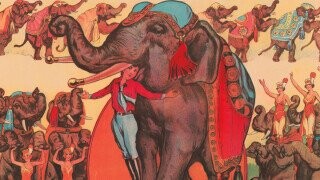The Florida Town Which Was A Refuge For Sideshow Performers

In Hillsborough County, Florida, just south of Tampa, there is a town of about 18,500 residents. Today, it looks like most other small towns in the region, but in a past life, it was a space filled with circus performers, sideshow acts, and everyone else under the “carny” umbrella.
Gibsonton, or Gibtown as it is often known, was once a place where traveling carnival performers could live in peace during the winter months, an off-season for these types of shows. Rather than just being a wintering destination, though, it was a vibrant community where sideshow performers could live without judgment.
In average society, these performers were seen as “freaks,” oddities that were so strange that people would pay just to look at them. In Gibtown, they were simply humans. The community catered to them too. Little people were common carnival performers, and many of them made homes in Gibsonton. To accommodate them, the Gibstonton post office had shelves at a height they could reach. Additionally, zoning laws permitted residents to have elephants and other exotic pets that traveled with them to circus shows.
Don't Miss
Sideshow spectators may have believed that the people they watched were “freaks,” but Gibsonton showed just how normal these performers were. In 1949, a Gibsonton couple opened a camping and fishing park that became popular among Floridians. The Gibsonton couple consisted of circus giant Al Tomaini and his wife, the “Half Girl” with no legs Jeanie Tomaini. Outside of Gibsonton, they may have been viewed as an odd attraction, but in their home, they were accepted and given the chance to show that they were no different than anyone else.
Not everything in Gibsonton helped eliminate the stigma against “freaks,” though. Some baselessly considered the town dangerous due to its residents. However, in 1992, Gibsonton’s reputation took a downward turn when a prominent sideshow act known as the Lobster Boy was murdered. Grady Stiles was a sideshow performer who dealt with ectrodactyly, a condition that fused fingers to give his hands a lobster claw-like appearance. Stiles was also a known alcoholic, abuser, and … uh, convicted murderer. No, seriously. He killed his daughter's fiancé the night before their wedding and got away with house arrest because prisons weren't equipped to hold him. Apparently sick of Stiles' history of abuse, Stiles' wife and stepson paid a 17-year-old neighbor to kill him. This event made rounds across tabloids and portrayed Gibsonton and carnies in general in a bad light.
For better or worse, sideshows fell out of style, and with them, Gibsonton lost its uniqueness. The town’s carny-centered features like the post office went away, and staples of a “normal” community like Walmart moved in. Members of the community have worked to keep the memories of the carny haven alive, though. The Showmen’s Museum operates to show the lives of the performers that lived and worked in the area.
The memories of Gibtown show an often-forgotten time in American history. Sideshows have mostly been condemned now, as displaying “weird” humans as entertainment is hardly a sensitive activity. Many of Gibsonton’s residents were proud of their work, though. They knew that every rude person they passed was going to stare and laugh at them. Making a living out of it turned the gawking public into the real “freaks.” And after the performers finished their carnival shows, they got to go home to Gibsonton and live in an accepting town of folks like them.
Top Image: Downie Bros. Big 3 Ring Circus